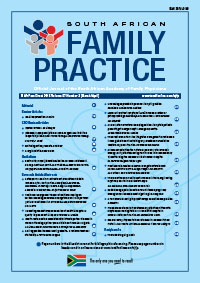Preventing venous thromboembolism at a district hospital: a quality improvement study
Keywords:
district hospital, quality improvement, venous thromboembolism prevention
Abstract
Background: Pulmonary embolism (PE) is the most common preventable cause of hospital deaths, and almost all hospitalised patients have at least one risk factor for venous thromboembolism (VTE). Despite the availability of highly effective thromboprophylaxis in preventing VTE, numerous studies worldwide have demonstrated its under-utilisation. The aim of this study was to review and improve the utilisation of thromboprophylaxis in the prevention of VTE in hospitalised patients at Oudtshoorn district hospital, and to make recommendations to the Western Cape Department of Health on how to improve the quality of care for patients at risk for VTE at district hospitals. Method: A quality improvement cycle (QIC). Retrospective analysis of files of adult patients admitted to the male and female wards at Oudtshoorn district hospital was performed prior to and after a five-month intervention phase. The target standards for the QIC were: (1) availability of a written hospital policy on VTE prevention; (2) every adult admission should have a formal VTE risk assessment documented; (3) every adult admission who is at risk for VTE should receive thromboprophylaxis. Results: Some 38% of adult patients admitted to Oudtshoorn Hospital, excluding the maternity ward, were at risk of developing VTE. There was no written hospital policy on VTE prevention. This was developed and made available during the intervention. In the pre-intervention group there were no patients who had a documented VTE risk assessment. The post intervention group showed a considerable increase with 45.2% having had a completed VTE risk assessment on admission (p < 0.001). In the pre-intervention group only 4.6% of patients who were at risk of VTE received thromboprophylaxis. There was a statistically significant difference in the number of patients at risk who received thromboprophylaxis in the post-intervention group where 36% of these patients received thromboprophylaxis (p < 0.001). Conclusions: The study identified a major shortcoming in the prevention of VTE in those patients at risk who were admitted to Oudtshoorn district hospital. An intervention as part of a quality improvement cycle has been able to demonstrate a significant improvement in the detection of patients who are at risk of VTE and a subsequent improvement in appropriate thromboprophylaxis. A number of barriers to their implementation have been identified and need to be addressed. This QIC may in time be of value to assist other district hospitals in addressing the issue of VTE prevention. (Full text available online at www.medpharm.tandfonline.com/ojfp) S Afr Fam Pract 2015; DOI: 10.1080/20786190.2014.977033
Published
2015-05-18
Section
Research Articles
By submitting manuscripts to SAFP, authors of original articles are assigning copyright to the South African Academy of Family Physicians. Copyright of review articles are assigned to the Publisher, Medpharm Publications (Pty) Ltd, unless otherwise specified. Authors may use their own work after publication without written permission, provided they acknowledge the original source. Individuals and academic institutions may freely copy and distribute articles published in SAFP for educational and research purposes without obtaining permission.

